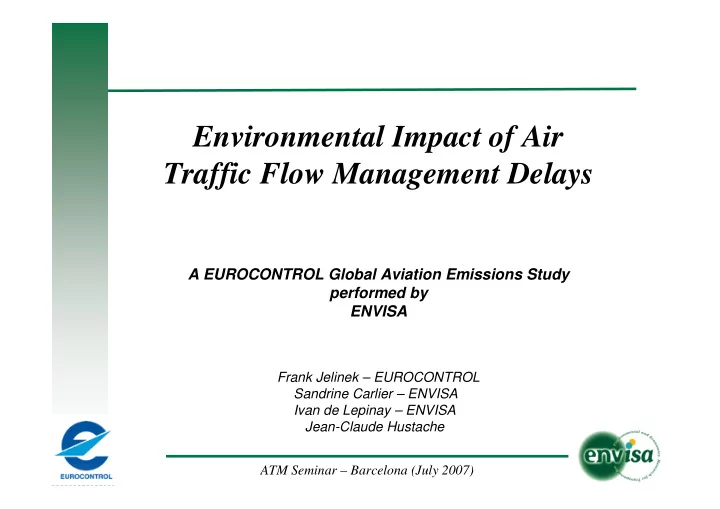

Environmental Impact of Air Traffic Flow Management Delays A EUROCONTROL Global Aviation Emissions Study performed by ENVISA Frank Jelinek – EUROCONTROL Sandrine Carlier – ENVISA Ivan de Lepinay – ENVISA Jean-Claude Hustache ATM Seminar – Barcelona (July 2007)
Background � Air traffic in Europe is regulated by the Central Flow Management Unit (CFMU) � Regulation of traffic mainly relies on ground delay principles for � Safety reasons � Economic reasons ATM Seminar – Barcelona (July 2007)
Objectives (1) � Conduct an environmental and economic assessment of ground delay practices and of airborne delay alternatives � Initial exercise � Reduced traffic sample � A lot of assumptions � Very general results and conclusions ATM Seminar – Barcelona (July 2007)
Objectives (2) � Obtain orders of magnitudes of environmental costs of different delay strategies (ground vs. airborne) based on simplified but representative traffic samples � Assess impacts on local and global emissions � Consider only delays resulting from ATFM (Air Traffic Flow Management) regulation ATM Seminar – Barcelona (July 2007)
Approach � Define scenarios and assumptions � Select traffic sample � Set up environmental simulation tools � Compute local pollution and global emissions for each scenario � Analyze results and convert into financial terms ATM Seminar – Barcelona (July 2007)
Definition of scenarios and assumptions – Ground Delays (1) Depends on aircraft, airport, delay duration Proportion of Operating mode time spent At gate with GPU only 81% At gate with APU only 9% Off-gate stationary ground 10% or active taxi out Source :University of Westminster, Transport Studies Group (2004) Evaluating the true cost to airlines of one minute of airborne or ground delay ATM Seminar – Barcelona (July 2007)
Definition of scenarios and assumptions – Airborne Delays (1) � Holding description ATM Seminar – Barcelona (July 2007)
Definition of scenarios and assumptions – Airborne Delays (2) � Flight re-routing assumptions Arrival Arrival Average distance between Average distance between entry point and closest entry point and closest outbound = 50 km outbound = 50 km Total distance without Total distance without congestion = 500 to 1000 km congestion = 500 to 1000 km Departure Departure Congested sector Congested sector Average transit time = 9 min Average transit time = 9 min Average transit distance = 100 km Average transit distance = 100 km ATM Seminar – Barcelona (July 2007)
Definition of scenarios and assumptions – Airborne Delays (3) Depends on airport, delay duration Location of the regulation En-route Arrival airport (50% of CFMU statistics) (50% of CFMU statistics) Holding stack 0% 100% Rerouting 100% Not possible Speed control alternative not investigated in this study. ATM Seminar – Barcelona (July 2007)
Delay distribution � 8.5% of 8.9 million flights in 2004 were delayed by at least 5 minutes because of ATFM regulations Delay duration % total traffic Number of flights (minutes) 0 – 4 91.4 Not considered delayed 5 – 15 4.6 409,400 16 – 30 2.7 240,300 31 – 60 1.0 89,000 > 60 0.2 17,800 ATM Seminar – Barcelona (July 2007)
Traffic sample selection � In 2004, 14.9 million ATFM delays in Europe � The 16 most congested airports generate 80% of European airport delays � The top 16 aircraft types operating at these airports were identified ATM Seminar – Barcelona (July 2007)
Setting up environmental simulation tools � Ground delays: ALAQS database � Aircraft type grouped by category (turboprop, jet regional, jet small, jet medium, jet large) � Airborne delays: AEM methodology � BADA 3.6 � ICAO Engine Exhaust Emissions Data Bank � Boeing Method 2 ATM Seminar – Barcelona (July 2007)
Conversion into financial terms Unit costs (€/tonne) Low Base High CO 2 11 37 65 H 2 O 2.8 8.3 14 NO x 4,460 6,414 10,693 SO x 2,110 6,094 11,133 HC 2,569 5,543 8,518 CO 104 142 205 ATM Seminar – Barcelona (July 2007)
Conclusions (1) Relative cost reduction of ground delay vs. airborne delay by pollutant Ground Cost Reduction (% of Airborne Cost) Fuel, CO2, H2O, SOx NOx HC CO 0 -10 -20 -30 -40 -50 -60 -70 -80 -90 -100 ATM Seminar – Barcelona (July 2007)
Conclusions (2) � The impact of ground delays varies with the power source used during the delay � Applying ground delays rather than airborne delays results in immediate environmental benefits Airborne delay vs. Ground delays Fuel consumption X 6 Non linear emissions X 3 Cost X 5 ATM Seminar – Barcelona (July 2007)
Conclusions (3) � The application of the ground delay principle in EUROPE saves 80M€ annually including � 60M€ in fuel savings and � 20M€ in emission cost savings ATM Seminar – Barcelona (July 2007)
Thank you ATM Seminar – Barcelona (July 2007)
Recommend
More recommend